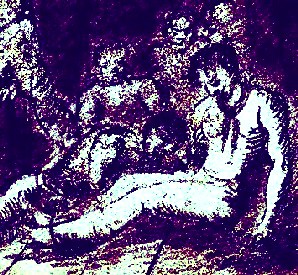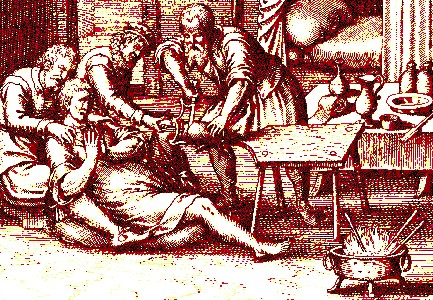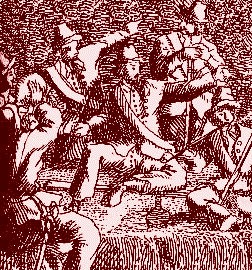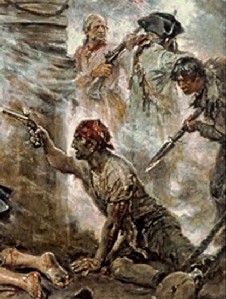
Health 'Insurance' at Sea: 1 2 3 4 5 6 7 8 9 10 11 12 13 Next>>
Health 'Insurance' at Sea During the Golden Age of Piracy, Page 3
Ship's Surgeon Provision – Men's Opinion of the Surgeon
"And no doubt, the better opinion the officers and men conceive of their surgeon, the more spirits

Wounded Waiting For Surgery Below Deck (1820)
they have for the action; being confident, the wounds, &c. they may chance to receive will be properly treated, and their lives (if possible) preserved." (Baron [Gerard] Van Swieten, The Diseases Incident To Armies, With The Method Of Cure, Published in 1758, Translated in 1776, p. 129)
Sailor's opinions about their sea surgeons seem to have varied more than those of the naval hierarchy or modern historians looking back. This may reflect the variations in the quality of the individual surgeons (which would have existed) and how they treated their patients. It may also reflect a lack of understanding on the part of the sailors about the treatment they were receiving (which also would have existed.)
Edward Barlow complained about the sea surgeons and shipboard physicians he encountered in 1672. He opined that
the surgeons and doctors of physic in ships many times are very careless of a poor man in his sickness, their common phrase being to come to him and take him by the hand when they hear that he hath been sick two or three days, thinking that is soon enough, and feeling his pulses when he is half dead, asking when he was at stool, and how he feels himself, and how he has slept, and then giving him some of their medicines upon the point of a knife, which doeth as much good to him as a blow upon the pate [top of the head] with a stick.1
Given that the surgeon was expected to daily visit the sick and ill, it seems unlikely that most men waited two or three days as Barlow suggests, unless he had a particularly incompetent surgeon. It is worth mentioning that Barlow's Journal reveals him to be something of a whiner - he also complains about the food, work, weather and accomodations at sea in the part of his journal when he was a regular sailor. Nevertheless, East India Company sea surgeon John Woodall's book does recommend giving grains of medicine to men "on the point of a knife" several times2, so Barlow's concerns cannot be entirely dismissed as mere grumbling.

Artist: William Hogarth
Physicians Debating from A Harlot's Progress, plate 5 (1730)
Barlow's comment about a ship's physicians is interesting in that they were only rarely found shipboard. A physician's practice revolved around the diagnosis of illnesses and diseases and the prescription of medicines to treat them. ('Physic' is another word for medicine.) Physicians books frequently spend as much time debating (and refuting) other physicians theories about illnesses as they do discussing medicines and other treatments.
However, the Commonwealth government recognized a need for physicians to diagnose patients and prescribe appropriate medicines in the navy. With this in mind, they assigned a physician to accompany the fleet to the West Indies in 1654.3 In addition, during wars, each English harbor had a physician so that when ill men were brought ashore, their condition could be properly diagnosed. However it wasn't until 1691, when the navy was faced with a debilitating wave of shipboard illnesses that the Secretary of the Admiralty saw fit to request the "Colledge of Physitians to nominate some able Physitians to go to sea with the Fleet"4 resulting in a physician being assigned to each squadron.

Leg Amputation, From De Gangrena et Sphacelo, by Willhem Hildanus (1617)
Surgeons were also sometimes accused by the men of being overenthusiastic in embracing certain procedures in an effort to speed the healing process and attend as many men as quickly as possible during battles.
Lieutenant Stephen Martin's left thigh was broken by a cannon ball in 1689, "and as upon these occasions they are in too great a hurry and confusion to consider properly the circumstances of every patient, so the surgeon had determined to cut off his leg, and prepared accordingly; but Mr. Martin coming to himself, and perceiving what they were about, he would by no means consent to it, declaring he would live or die with his legs on, and by this resolution he saved his leg."5
Sometimes the surgeon was just found to be no good. While visiting a sick man on a 'West-Indian shallop' with a diarrhoeic fever, doctor Thomas Aubrey commented,
They had a kind of a Barber-Surgeon on Board, which they might have as well been without, only that he served well enough to shave and bleed [let blood]. I demanded of him, how he had treated the Mate, he said he had blooded him three times, and purged him as often, but with what he could scarcely tell me, or else was ashamed to let me know, altho' he had a [medicine] Chest very handsomly furnished with Medicines for such a Vessel, had he had but Judgment to make use of them. Thus many poor Souls are cast away by the Ignorance of such Vermin, who without Consideration, or Conscience, undertake the Charge of a Vessel.6

Artist: Jan van der Straet - Feeding a Patient Liquids (1600)
Aubrey stopped the bloodletting and provide an electuary and a medicinal decoction mixed in canary wine. He also changed the man's diet to include "good strong Broths made with Fowls, and some of the Beef of the Country boiled together, and also sometimes a little Rice... [and] sometimes he had a Chick roasted"7. This led to the man's recovery.
Captain Nathaniel Uring encountered a similar problem when his ship arrived in Campeche in 1712. Eight of his men died there of 'a Malignant Fever' "for want of a skilful Surgeon."
When that Distemper began first, every one that was infected with it died, which made me question my Surgeon’s Ability, and therefore I enquired into his method of proceeding with the Sick: As soon as any one was taken sick, he let them Blood; and if he found the Pulse beat strong and quick he bled them again, and continued to do so ‘till they had lost all their Spirits, and then they expired. When I found this ill Practice I would not suffer him to administer any Physick, or do any thing to the Patient till I had seen first him8
In fact, such a course of bloodletting was not unusual for patients with fevers at this time. However, since the surgeon's efforts were failing, Captain Uring rightfully changed the treatment regime which preserved the rest of his men. It was the captain's privilege to overrule the surgeon when he thought it proper to maintain the health of the men or the needs of the ship. As historian John Keevil notes, "a surgeon's loss of a captain's confidence could quickly lead to complete undermining of such slender professional authority as he might until then have commanded."9
John Woodall's book for surgeon's mates contained a number of admonitions to surgeon's mates. They were to avoid "errours too grosse, which I have observed to have beene committed by some, that hee might avoide the like in himself" and invite the disfavor of his seniors.10 Among his warnings, Woodall told the surgeons mates to avoid "all unprofitable, idle, and unseemly actions" as well as "the Pot [probably referring to alcohol] and Tobacco-pipe in such an unreasonable measure, that thereby they become in themselves base, despising virtue and commending vice". He also advised against being "of a proud lasie [lazy] disposition"11.

Edward Low's Men Saluting the Surgeon (Not Really)
From Histoire der Engelsche zee-roovers (1725)
Other sailors had good things to say about their ship's surgeon. Keevil notes that "Certainly the sea-surgeons of this period were more skilled and more highly esteemed than their predecessors, and in all the immense mass of records relating to the Commonwealth and Protectorate [1653-9] , none containing criticism of them has yet been discovered: the charlatans and mountebanks, against whom Clowes had railed, had completely disappeared."12 ('Clowes' refers to military and naval surgeon William Clowes who was practicing in the late 16th century. In his book he complained about the quack surgeons found in England during that period.13)
The sailors on the James Galley who were tended to by sea surgeon John Moyle actually wrote in praise of him:
We the mariners belonging to His Majesty's Ship James Galley have many of us been desperately sick of malignant fevers and fluxes, and by the scurvy, an others of the crew were wounded and bruised by accidents aboard the same ship but all of us and many more have been safely cured again by the care and skill of our chirurgion in Mr John Moyle who hath... sufficiently proved himself both a very able surgeon and an honest man by his behaviour, hath been so civil towards all men that he hath an extraordinary respect from the ship's company in general.14

Artist: John Clevely the elder
6th Rate Sloop of War on Stocks Showing Deck Locations (1758)
Like Keevil, historian Peter Earle notes that he found few comments on the men's opinion of their surgeon. However, "the regret expressed when surgeons died... suggests that sailors thought they were at least better off with a surgeon than without one"15. With their protection in mind, the surgeon was usually placed in the safest part of a ship - the cable tier on smaller ships and the orlop deck on larger ones - where he was as close as possible to the waterline. This was less likely to be hit by cannonballs during a skirmish. As Sir William Monson wrote in his Naval Tracts in the early 17th century, "The surgeon is to be placed in the hold, where he should be in no danger of shot; for there cannot be a greater disheartening of the company than in his miscarrying, whereby they will be deprived of all help for hurt and wounded men."16
Historian R.S. Allison explains that "few seamen would enter a fight unless they could be assured that there was a capable surgeon to attend to them if they were wounded. Thus it is recorded in 1627 that the seaman would do nothing without a chirurgeon, and in 1628, the crew of the HMS Rainbow actually deserted from the ship because it had become known that the medicine chest was empty."17
1 Edward Barlow, Barlow's Journal of his Life at Sea in King's Ships, East and West Indiamen & Other Merchantman From 1659 to 1703, p. 214; 2 See for example John Woodall, the surgions mate, 1617, p. 158 & 186; 3 John J. Keevil, Medicine and the Navy 1200-1900: Volume II – 1640-1714, p. 28; 4 Keevil, p. 253; 5 Clements Robert Markham, ed, Life of Captain Stephen Martin, 1666-1704, 1895. p. 8-9; 6 Thomas Aubrey, The Sea-Surgeon or the Guinea Man's Vadé Mecum, 1729, p. 80; 7 Aubrey, p. 81; 8 Nathaniel Uring, A history of the voyages and travels of Capt. Nathaniel Uring, p. 168; 9 Keevil, p. 230-1; 10,11 John Woodall, the surgions mate, 1639, not paginated; 12 Keevil, p. 34;13 To see examples of his accusations, see William Clowes comments "To the Reader" in A Profitable and Necessarie Booke of Observations, for all those that are burned with the flam of Gun powder &c. 1588, not paginated; 14 Kevin Brown, Poxed and Scurvied: The Story of Sickness and Health at Sea, p. 49; 15 Peter Earle, Sailors - English Merchant Seamen 1650-1775, p. 138; 16 Sir William Monson's Naval Tracts, Edited by M. Oppenheim, 1913, p. 57-8;' 17 R. S. Allison, "Chirurgeon: Look to the Wounded," J Royal Medical Serv 1990, p 16
The Pirates Opinions
Pirates seem to have had an exceptionally good opinion of the office of the surgeon. The Solicitor General presenting the case against Edward Low's pirates noted that the surgeon was "ador'd among 'em as the pirates God for in him they chiefly confide for their cure and life, and in this trust and dependence it is"1.

Artist: Jean Leon Gerome Ferris
Wounded Pirates, From The Capture of the
Pirate Blackbeard (1920)
When pirate captain William Fly's crew mutined and took control of the Elizabeth in 1726, they drowned the captain and mate, but "debated what should be done with the doctor. Some were for sending him to look after the captain and mate; but the majority, as he was a useful man, thought it better to keep him."2
Fly's pirates were not the only ones so inclined. In 1687, the crew of the Cygnet decided to mutiny by taking the ship when it was docked in Mindanao because captain Charles Swan didn't seem inclined to leave. William Dampier explains, "all that were aboard bound themselves by Oath to turn Captain Swan out, and to conceal this Design from those that were ashore, until the Ship was under Sail; which would have been presently, if the surgeon and his Mate had been aboard; but they were both ashore, and they thought it no Prudence to go to Sea, without a Surgeon"3. To enable their departure, they tricked surgeon's mate Herman Coppinger to come on board under the pretense of a man having broken his leg, requiring immediate medical attention.
The surgeon was so valued as a crew member that even some pirate captains gave them some leeway. After Edward Low "very opportunely received the Stroke upon his under Jaw, which laid the Teeth bare"4, he complained about surgeon John Kencate's stitching. The surgeon "struck Low such a Blow with his Fist, that broke out all the Stitches, and then bid him sew up his Chops himself and be damned, so that Low made a very pitiful Figure for some Time after."5
1 George Francis Dow and John Henry Edmonds, Pirates of the New England Coast, p. 303; 2 Captain Charles Johnson, The History of the Pirates, p. 136; 3 William Dampier, Memoirs of a Buccaneer, Dampier's New Voyage Round the World -1697-, 2012, p. 214; ,4,5 Captain Charles Johnson, The General History of the Pyrates, 3rd edition, p. 374

